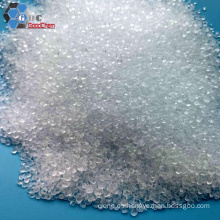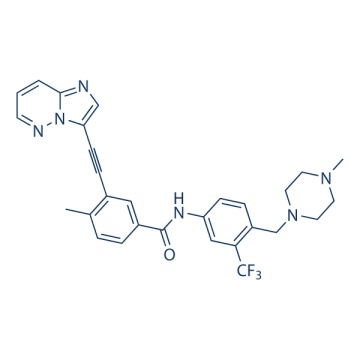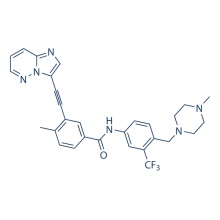.cp_wz tabla {borde superior: 1px sólido #ccc; borde izquierdo: 1px sólido #ccc; } .cp_wz table td {borde derecho: 1px sólido #ccc; borde inferior: 1px sólido #ccc; padding: 5px 0px 0px 5px;} .cp_wz table th {border-right: 1px solid #ccc; border-bottom: 1px solid #ccc; relleno: 5px 0px 0px 5px;} \ n Peso molecular: \ n 473,98 Pazopanib (GW786034) es un nuevo inhibidor multiobjetivo de VEGFR1, VEGFR2, VEGFR3, PDGFR, FGFR, c-Kit y c-Fms con IC50 de 10 nM , 30 nM, 47 nM, 84 nM, 74 nM, 140 nM y 146 nM, respectivamente. \ N Actividad biológica Pazopanib inhibe de forma potente la fosforilación de VEGFR2 inducida por VEGF en células HUVEC con IC50 de 8 nM. Pazopanib muestra inhibición del crecimiento dependiente de la dosis en todas las líneas celulares de sarcoma sinovial, incluidas las células SYO-1 y HS-SY-II. La proliferación de células SYO-1 y HS-SY-II se inhibe incluso con 1 µg / ml de pazopanib y se elimina por completo con 5 µg / ml. Pazopanib induce la detención de G1 y, por lo tanto, suprime el crecimiento de las células del sarcoma sinovial. La fosforilación de Akts, GSK-3β, JNK, p70 S6 quinasa y mTOR se suprime en las células SYO-1 tratadas con pazopanib en comparación con las células tratadas con vehículo. El pazopanib entre 20 mg / ml y 22,5 mg / ml muestra una reducción creciente de la viabilidad de las células del EPR. Los ratones tratados con 30 mg / kg o 100 mg / kg de pazopanib revelan una disminución significativa en la carga tumoral en comparación con los ratones tratados con vehículo o 10 mg / kg de pazopanib. El tratamiento con pazopanib se tolera bien y no hay una diferencia significativa en el peso corporal entre los ratones de cada grupo. Protocolo (solo como referencia) Ensayo de quinasa: [1]
|
Kinase enzyme assays
|
VEGFR enzyme assays for VEGGR1, VEGFR2, and VEGFR3 are run in homogeneous time-resolved fluorescence (HTRF) format in 384-well microtiter plates using a purified, baculovirus-expressed glutathione-S-transferase (GST) fusion protein encoding the catalytic c-terminus of human VEGFR receptor kinases 1, 2, or 3. Reactions are initiated by the addition of 10 μL of activated VEGFR2 kinase solution [final concentration, 1 nM enzyme in 0.1 M HEPES, pH 7.5, containing 0.1 mg/mL bovine serum albumin (BSA), 300 μM dithiothreitol (DTT)] to 10 μL substrate solution [final concentration, 360 nM peptide, (biotin-aminohexyl-EEEEYFELVAKKKK-NH2), 75 μM ATP, 10 μM MgCl2], and 1 μL of titrated Pazopanib in DMSO. Plates are incubated at room temperature for 60 min, and then the reaction is quenched by the addition of 20 μL of 100 mM ethylene diamine tetraacetic acid (EDTA). After quenching, 20 μL HTRF reagents (final concentration, 15 nM Streptavidin-linked allophycocyanin, 1 nM Europium-labeled antiphosphotyrosine antibody diluted in 0.1 mg/mL BSA, 0.1 M HEPES, pH 7.5) is added and the plates incubated for a minimum of 10 min. The fluorescence at 665 nM is measured with a Wallac Victor plate reader using a time delay of 50 μs.
|
Ensayo celular: [1]
|
Cell lines
|
HUVEC cells
|
|
Concentrations
|
0-10 μM
|
|
Incubation Time
|
1 hour
|
|
Method
|
Phosphorylation of VEGFR2 is assessed in HUVEC stimulated with VEGF. HUVEC are plated in type-I collagen-coated 10 cm plates in Clonetics EGM-MV medium at 1.0-1.5 × 106 cells/plate. After 24 hours, the confluent cells are serum starved overnight by replacing the growth medium with Clonetics EBM medium containing 0.1% BSA, 500 μg/mL hydrocortisone. Cells are treated with Pazopanib at various concentrations for 1 hour, followed by addition of 10 ng/mL VEGF or vehicle for 10 min. Cells are solubilized in lysis buffer. VEGFR2 is immunoprecipitated using antiflk-1 antibody and analyzed by sodium dodecyl sulfate polyacrylamide gel electrophoresis (SDS-PAGE) followed by Western blotting and detection with antiflk-1 or with antiphosphotyrosine (anti-P-tyr-biotin) antibody. The VEGFR2 phosphorylation level is quantified by densitometry and normalized to the total VEGFR2 level.
|
Estudio con animales: [2]
|
Animal Models
|
Immunodeficient mice bearing SYO-1 cells
|
|
Formulation
|
|
|
Dosages
|
0 mg/kg, 10 mg/kg, 30 mg/kg, or 100 mg/kg
|
|
Administration
|
Oral administration
|
|
Solubility
|
30% PEG400/0.5% Tween80/5% propylene glycol,
30 mg/mL
|
|
* Please note that Selleck tests the solubility of all compounds in-house, and the actual solubility may differ slightly from published values. This is normal and is due to slight batch-to-batch variations.
|
Conversión de diferentes modelos de animales basados en BSA (valor basado en datos del Borrador de Directrices de la FDA)
|
Species
|
Baboon
|
Dog
|
Monkey
|
Rabbit
|
Guinea pig
|
Rat
|
Hamster
|
Mouse
|
|
Weight (kg)
|
12
|
10
|
3
|
1.8
|
0.4
|
0.15
|
0.08
|
0.02
|
|
Body Surface Area (m2)
|
0.6
|
0.5
|
0.24
|
0.15
|
0.05
|
0.025
|
0.02
|
0.007
|
|
Km factor
|
20
|
20
|
12
|
12
|
8
|
6
|
5
|
3
|
|
Animal A (mg/kg) = Animal B (mg/kg) multiplied by
|
Animal B Km
|
|
Animal A Km
|
Por ejemplo, para modificar la dosis de resveratrol utilizada para un ratón (22,4 mg / kg) a una dosis basada en el BSA para una rata, multiplique 22,4 mg / kg por el factor Km para un ratón y luego divida por el factor Km para una rata. Este cálculo da como resultado una dosis equivalente para ratas de resveratrol de 11,2 mg / kg.
|
Rat dose (mg/kg) = mouse dose (22.4 mg/kg) ×
|
mouse Km(3)
|
= 11.2 mg/kg
|
|
rat Km(6)
|
Información química
|
Molecular Weight (MW)
|
473.98
|
|
Formula
|
C21H23N7O2S.HCl
|
|
CAS No.
|
635702-64-6
|
|
Storage
|
3 years -20℃Powder
|
|
6 months-80℃in solvent (DMSO, water, etc.)
|
|
Synonyms
|
|
|
Solubility (25°C) *
|
In vitro
|
DMSO
|
17 mg/mL
(35.86 mM)
|
|
Water
|
<1 mg/mL
(
|
|
Ethanol
|
<1 mg/mL
(
|
|
In vivo
|
30% PEG400/0.5% Tween80/5% propylene glycol
|
30 mg/mL
|
* <1 mg/ml means slightly soluble or insoluble.
* Please note that Selleck tests the solubility of all compounds in-house, and the actual solubility may differ slightly from published values. This is normal and is due to slight batch-to-batch variations.
|
|
Chemical Name
|
5-(4-((2,3-dimethyl-2H-indazol-6-yl)(methyl)amino)pyrimidin-2-ylamino)-2-methylbenzenesulfonamide hydrochloride
|
Calculadora de molaridad Calculadora de dilución Calculadora de peso molecular
Grupos de Producto : Angiogénesis > Inhibidor de Bcr-Abl






